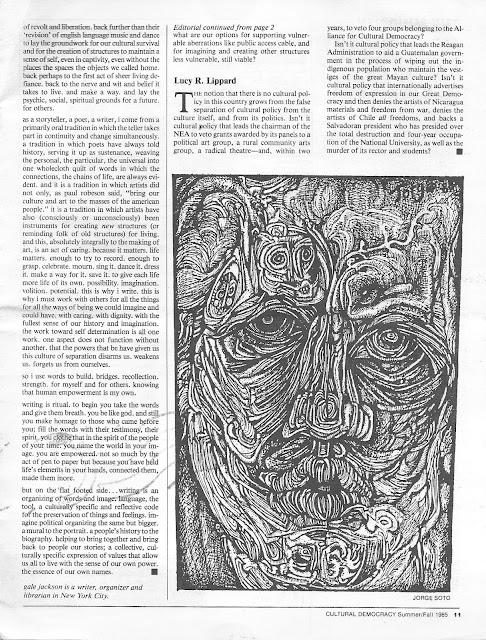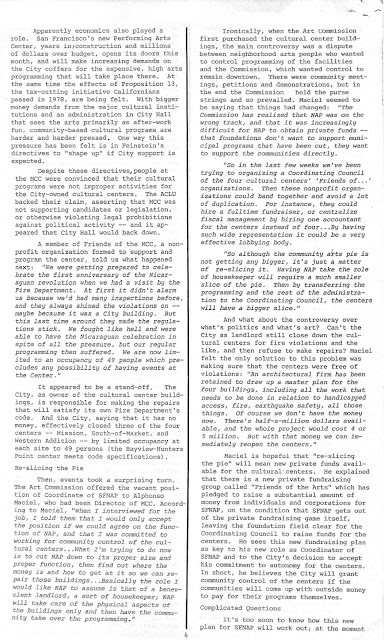NOTE to readers: Please think of this as a kind of oral history rather than a definitive account. I relied on a few documents and essays and my own memories to create it. If others want to suggest corrections that reflect their own first-person experience, please feel free. - Arlene Goldbard, 24 April 2020
The organization that came to be known as the Alliance for Cultural Democracy (ACD) began life as the Neighborhood Arts Programs National Organizing Committee, NAPNOC for short. NAPNOC was started by Eric Val Reuther, son of Victor Reuther of the United Auto Workers clan. I first met Eric in San Francisco in the early seventies. He served for a time as associate director of the San Francisco Neighborhood Arts Program, generally called NAP or SFNAP. (You can read a bit about it, including a short essay I wrote for a 2018 exhibit honoring its fiftieth anniversary, here.) I worked at NAP as a graphic designer, churning out posters for community arts events.
Eric was at NAP when John Kreidler came there as an intern, fresh from the Office of Management and Budget in Washington, bringing news of a new public service jobs program, the Comprehensive Employment and Training Act (CETA). He guided NAP though obtaining and hiring for the first CETA arts jobs in 1974. (You can read a bit more about this in an excerpt from my book New Creative Community here.
The notion of developing CETA jobs for artists was exciting, harking back to Federal One of the WPA of the 1930s, and a natural for Eric given his roots in organized labor. After he left SFNAP, he set about organizing a coalition of what we might now call community-based arts groups (“neighborhood arts to him”). Using his Department of Labor access in Washington during the Carter administration, Eric secured a substantial amount of funding to set up regional CETA arts programs to offer technical assistance, document the phenomenon, and expand public service jobs for artists.
Using his Department of Labor access in Washington during the Carter administration, Eric secured a substantial amount of funding to set up regional CETA arts programs to offer technical assistance, document the phenomenon, and expand public service jobs for artists.Eric’s was an old-school approach to organizing, very much grounded in personal relationship and loyalty. NAPNOC’s founding meeting was held at the United Auto Workers’ Family Education Center in Black Lake, MI, in December 1976, bringing together 50 community arts activists and some allies to plan the new initiative. The Department of Labor granted NAPNOC funding in November 1977 to “demonstrate the potential” of CETA arts. The regional NAPNOC CETA offices in Knoxville and San Francisco had some scope to set their own agendas, but the project was marked by friction over autonomy and control.CETA arts became a huge, nationwide effort. Steve Durland and Linda Burnham republished two reports that outline the approximately $200 million a year eventually allocated to public service arts employment. You can find them on Kindle: CETA and the Arts: Analyzing the Results of a Groundbreaking Federal Job Program and CETA and the Arts II: Fifteen Case Studies.
It all looked quite promising until things started to turn rightward: in California, Proposition 13 was passed by referendum (the first of the “taxpayer revolt” initiatives that had a destructive effect on public spending for community and culture); and worst of all, Ronald Reagan was elected President.
NAPNOC hired Don Adams and myself to research the impact of Prop. 13 and write a report that was published in 1978: California Community Arts Under Proposition 13. This was welcome work not only because of shared values and the chance to call attention to important issues, but because we’d recently had a disastrous time with the California Arts Council which had hired us to draft a cultural policy for the state of California, then—under pressure from the red-carpet arts institutions—denounced us and it as too radical.
For both personal and political reasons, around that time Eric moved on from NAPNOC. Don Adams and I were hired as co-directors and moved to Washington with the intention of broadening out the mission from CETA jobs to all the community-based work and democratic cultural policy work then going on.
Washington was in a tizzy with Carter administration cloth coats being replaced by Reagan administration furs and limos. It was clear from the first that public service employment was going to be no more, and former connections at the Department of Labor were not going to help. (In fact, at our first meeting with an official there before Reagan appointees took over, we were asked “What are you going to do to detoxify your organization?” This was a reference to some of the controversies that has gathered steam during NAPNOC’s well-funded CETA period). As you can see from the ACD Archive, we first published NAPNOC notes in June 1980. This was in a pre-tech age. The newsletter was typed by hand on an IBM Selectric, mimeo’d, and snail-mailed out.
We tried to cover cultural policy with a critical eye (you’ll find quite a few pieces about the NEA and other federal agencies in the archive, for instance); to expand the national organizing committee beyond the original folks who’d been involved; and to publish “round-robin” dialogues on important issues, created by interviewing folks around the country and braiding their views into an article exploring multiple dimensions.
We had quite an adventure in late 1980 going to the offices of the Heritage Foundation, which more or less wrote Reagan’s cultural policy before the election, and being allowed to take notes by hand summarizing the recommendations that were shortly to become official actions. We tried to cover the National Council for the Arts meetings—supposedly public—but we were ejected. Theo Bickel, then serving on the National Council, denounced cultural democracy as “subverting...democracy to an autocracy of the uninformed.” (More details in issue #6 of NAPNOC notes.) Washington the year Reagan was elected was not a particularly welcoming environment.
Tiring of NAPNOC (i.e., knock-knock) jokes, at its first annual meeting in Washington in May 1981, the membership approved renaming the organization the Alliance for Cultural Democracy and the newsletter’s name was changed to Cultural Democracy.
We relocated to more affordable Baltimore, finding allies through Philip Arnoult and the other folks connected to The Theatre Project at that time. While there were no longer any federal funds to support ACD as there had been in the NAPNOC/CETA days, we were able to obtain a few grants (the New World Foundation and the Mary Reynolds Babcock Foundation stick in my mind). When they ran out, we switched to a more or less pro bono relationship with ACD, supporting the time we spent organizing and writing through independent consulting work we took on. It definitely felt like a mission to help foment and support a movement, though I don’t know if the reality matched the feeling.
At this point in time, I guess we are no longer in origin-story territory. Most of what happened after that is pretty well documented in Cultural Democracy. The last issue I worked on was #27, January-February 1983. That year, we had a pretty terrible experience with the person who took over as ACD president and somehow managed to lose the fundraising mailing that was supposed to hold things together; without that stop-gap, we ran out of steam trying vainly to raise money to support ACD and finally moved on.
Looking back, I definitely think it was worthy to try to bring artists and organizers together across what had been barriers (e.g., cultural background, urban/rural, arts discipline and approach) to sense a common purpose. Early ACD had a positive role in connecting people, offering them language that resonated, and introducing cultural democracy and other important policy concepts into the dialogue.
The history of cultural subvention in this country—giving people just enough support to fail, treating community-based arts work as if it were always emerging, kind of an amateur version of the real thing, etcetera—was definitely the biggest obstacle, and to my mind, remains so. But in the writing, organizing, and other work I’ve done in the ensuing forty or so years (e.g., the USDAC), it’s interesting to see how much the same values and aims animate and drive me. You too?





















































